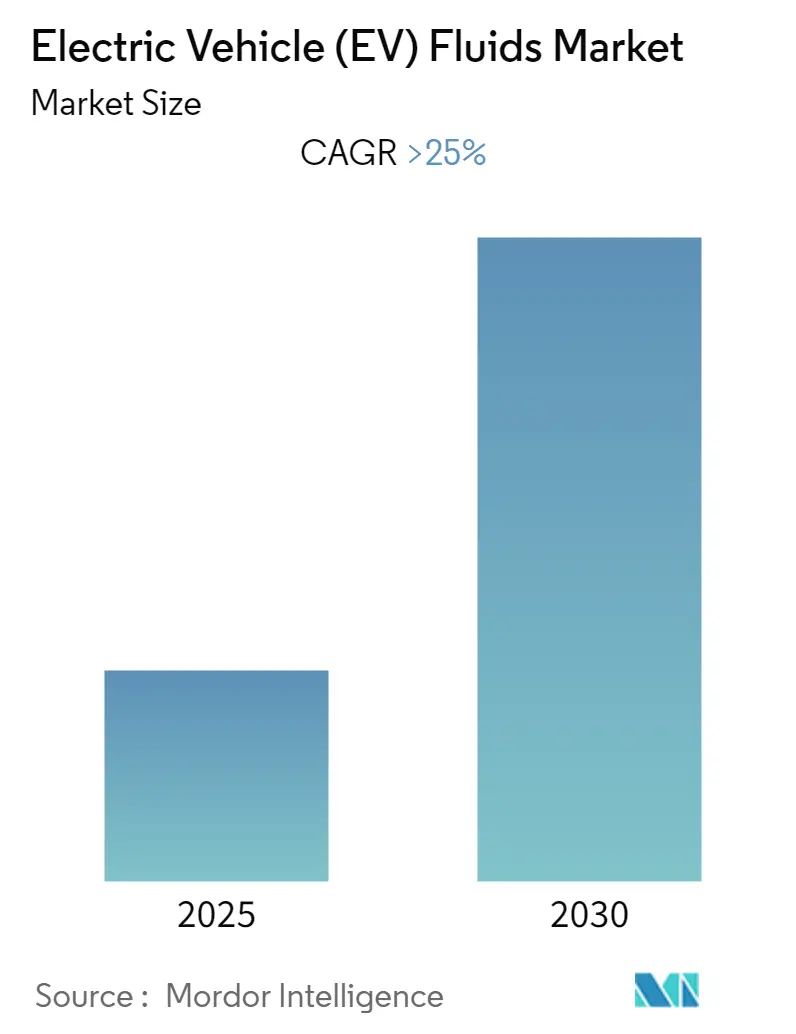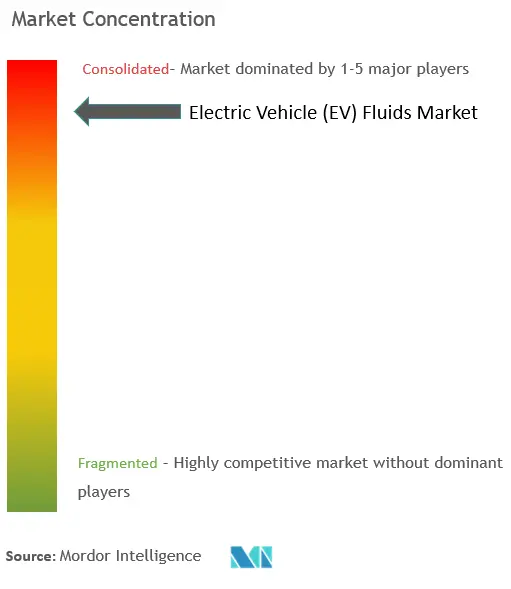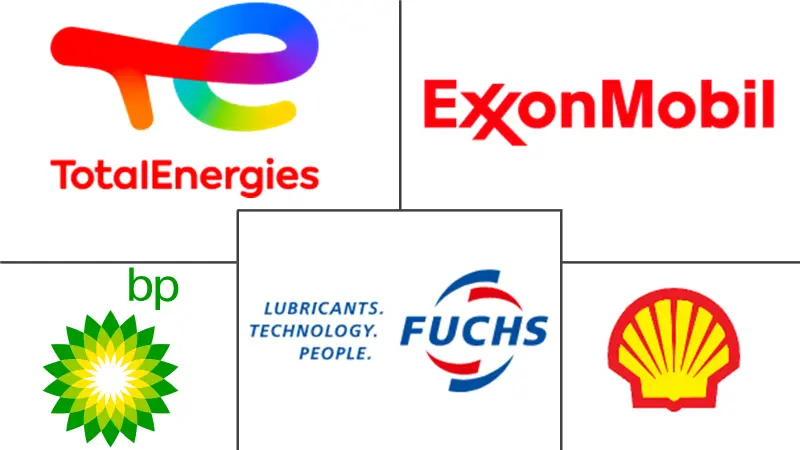Electric Vehicle (EV) Fluids Market Size and Share

Electric Vehicle (EV) Fluids Market Analysis by Mordor Intelligence
The Electric Vehicle Fluids Market is expected to register a CAGR of greater than 25% during the forecast period.
- The main driver of the market for electric vehicle fluids is the increased demand for EVs due to factors such as rising fuel prices, pollution levels, and the need to cut harmful vehicle emissions, among others.
- On the other hand, the market's expansion is anticipated to be hampered by the high initial cost of buying an electric vehicle compared to a fuel or diesel vehicle.
- Further, government regulations for a sustainable EV environment are projected to create market opportunities.
The Asia-Pacific region is the biggest market and is expected to grow the fastest over the next few years because countries like China, India, and Japan are using more and more.
Global Electric Vehicle (EV) Fluids Market Trends and Insights
Increasing Penetration of Electric Vehicles
- As batteries and motors are the main propulsion sources for EVs, they need a different combination of fluids than conventional vehicles. Conventional fluids are incompatible with EVs since they can cause viscosity issues and corrosion of parts, thus reducing the vehicle's overall performance and durability.
- Thus, with the growing demand for electric vehicles, the need for electric vehicle fluids rises, as these fluids control the temperature of the battery and power electronics while cooling the drivetrain and transmission system.
- Also, the EV grease lubricates the EV parts while reducing the vehicle's noise, vibration, and harshness levels. Furthermore, it performs the function of heat transfer.
- The rising production of electric vehicles is expected to enhance the market's demand.
- As per the World Economic Forum (WEF), nearly 4.3 million new battery-powered EVs (BEVs) and plug-in hybrid electric vehicles (PHEVs) were sold globally in the first half of 2022. Therefore, enhancing the demand for electric vehicle fluids during the forecast period.
- Moreover, according to the China Association of Automobile Manufacturing, the production of New Energy Vehicles in the country witnessed a year-on-year increase of 96.9 percent in December 2022. Thus, the expanding electric vehicle market is expected to increase the demand for electric vehicle fluids in the country.
- Thus, with the increasing demand for electric vehicles, the market is expected to grow significantly during the forecast period.

Asia-Pacific to Dominate the Market
- During the forecast period, Asia-Pacific is expected to dominate the electric vehicle fluids market with increased demand from countries like China and India.
- The region is expected to witness significant growth with the enhanced demand for electric vehicles and the increased government investment in enhancing the production of electric vehicles in order to reduce carbon emissions.
- According to the China Association of Automobile Manufacturers (CAAM), China has the largest automotive production base in the world. In July 2022, the number of battery-powered electric vehicles increased by 117.2% compared to January-July 2021. In July 2022, the country's electric vehicle sales were estimated at around 617,000 units.
- Furthermore, with the growing government initiatives in India to enhance e-mobility in the country, the sales number of two-wheeler electric vehicles is rising significantly.
- According to the Federation of Automobile Dealers Associations, the total number of two-wheel electric vehicles sold in the country reached nearly 231,000. Therefore, boosting the market for electric vehicle fluids during the forecast period
- The aforementioned factors, coupled with government support, are contributing to the increasing demand for the electric vehicle fluids market in Asia-Pacific during the forecast period.

Competitive Landscape
The global electric vehicle (EV) fluid market is consolidated in nature. Some of the major players in the market include Exxon Mobil Corporation, BP p.l.c., Shell plc, FUCHS, and TotalEnergies, among others (in no particular order).
Electric Vehicle (EV) Fluids Industry Leaders
-
Exxon Mobil Corporation
-
TotalEnergies
-
Shell plc
-
FUCHS
-
BP p.l.c.
- *Disclaimer: Major Players sorted in no particular order

Recent Industry Developments
- November 2022: TotalEnergies Marketing India Private Limited (TEMIPL) announced the debut of the new EV Fluid series of electric and hybrid automobiles and electric bikes in India.
- August 2022: Shell Lubricants announced the launch of heat transfer fluids in India for EV motors that are appropriate for climatic and geographical requirements.
Global Electric Vehicle (EV) Fluids Market Report Scope
EV fluids are lubricants that have been designed and developed specifically to suit the needs of electric vehicles. EV fluids keep the electric vehicle's powertrain and transmission system cool. The functions of the EV fluid include heat transfer, lubrication of EV parts, energy loss reduction, and improving the transmission system. The Electric Vehicle (EV) Fluid market is segmented by product type, propulsion type, vehicle type, and geography. By product type, the market is segmented into engine oil, coolant, transmission fluids, greases, and other product types. By propulsion type, the market is segmented into battery electric vehicles (BEVs), hybrid electric vehicles (HEVs), and plug-in hybrid electric vehicles (PHEVs). By vehicle type, the market is segmented into passenger vehicles, commercial vehicles, and other vehicle types. The report also covers the market size and forecasts for the market in 15 countries across the globe. For each segment, the market sizing and forecasts have been done on the basis of volume (kilo tons).
| Engine Oil |
| Coolant |
| Transmission Fluids |
| Greases |
| Other Product Types |
| Battery Electric Vehicles (BEVs) |
| Hybrid Electric Vehicles (HEVs) |
| Plug-in Hybrid Electric Vehicles (PHEVs) |
| Passenger Vehicles |
| Commercial Vehicles |
| Other Vehicle Types |
| Asia-Pacific | China |
| India | |
| Japan | |
| South Korea | |
| Rest of Asia-Pacific | |
| North America | United States |
| Canada | |
| Mexico | |
| Europe | Germany |
| United Kingdom | |
| France | |
| Italy | |
| Rest of Europe | |
| South America | Brazil |
| Argentina | |
| Rest of South America | |
| Middle-East and Africa | Saudi Arabia |
| South Africa | |
| Rest of Middle-East and Africa |
| Product Type | Engine Oil | |
| Coolant | ||
| Transmission Fluids | ||
| Greases | ||
| Other Product Types | ||
| Propulsion Type | Battery Electric Vehicles (BEVs) | |
| Hybrid Electric Vehicles (HEVs) | ||
| Plug-in Hybrid Electric Vehicles (PHEVs) | ||
| Vehicle Type | Passenger Vehicles | |
| Commercial Vehicles | ||
| Other Vehicle Types | ||
| Geography | Asia-Pacific | China |
| India | ||
| Japan | ||
| South Korea | ||
| Rest of Asia-Pacific | ||
| North America | United States | |
| Canada | ||
| Mexico | ||
| Europe | Germany | |
| United Kingdom | ||
| France | ||
| Italy | ||
| Rest of Europe | ||
| South America | Brazil | |
| Argentina | ||
| Rest of South America | ||
| Middle-East and Africa | Saudi Arabia | |
| South Africa | ||
| Rest of Middle-East and Africa | ||
Key Questions Answered in the Report
What is the current Electric Vehicle (EV) Fluids Market size?
The Electric Vehicle (EV) Fluids Market is projected to register a CAGR of greater than 25% during the forecast period (2025-2030)
Who are the key players in Electric Vehicle (EV) Fluids Market?
Exxon Mobil Corporation, TotalEnergies, Shell plc, FUCHS and BP p.l.c. are the major companies operating in the Electric Vehicle (EV) Fluids Market.
Which is the fastest growing region in Electric Vehicle (EV) Fluids Market?
Asia-Pacific is estimated to grow at the highest CAGR over the forecast period (2025-2030).
Which region has the biggest share in Electric Vehicle (EV) Fluids Market?
In 2025, the Asia-Pacific accounts for the largest market share in Electric Vehicle (EV) Fluids Market.
What years does this Electric Vehicle (EV) Fluids Market cover?
The report covers the Electric Vehicle (EV) Fluids Market historical market size for years: 2019, 2020, 2021, 2022, 2023 and 2024. The report also forecasts the Electric Vehicle (EV) Fluids Market size for years: 2025, 2026, 2027, 2028, 2029 and 2030.
Page last updated on:
Electric Vehicle (EV) Fluids Market Report
Statistics for the 2025 Electric Vehicle (EV) Fluids market share, size and revenue growth rate, created by Mordor Intelligence™ Industry Reports. Electric Vehicle (EV) Fluids analysis includes a market forecast outlook for 2025 to 2030 and historical overview. Get a sample of this industry analysis as a free report PDF download.



